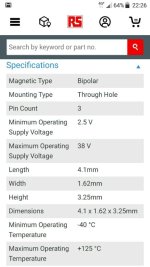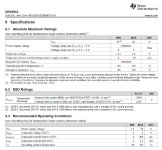kdog
10 kW
Hi all
I'm having a little trouble with a repair on a friend's Mac motor. He crashed on the motor cable exit side, munched his cables and blew the halls. The controller is fine (tested on another motor).
I've pulled new cable though (what a bitch!) and squared that all away no probs.
To order halls through RS online, I cross referenced the specs of Honeywell ss41 and matched them to a Texas instruments hall (this is all rs had) I ended up with these...
https://au.rs-online.com/mobile/p/hall-effect-sensor-ics/9009781/
Specs are as follows;
After several hours more work I got the halls in, but the motor doesn't go
When I tested the halls on my dmm, I was only getting 2v Max on (3.5v supply) but they turned on and off as expected.
The motor just locks straight up, doesn't try to turn. It's not the phase/hall combo....and I tried other combos just to be sure, with same result.
I'm suspecting I screwed up with the hall selection, which is confusing bc they seem a good match. However I am suspicious on the 2v issue. The original ones were 3.5v Max and seemed to turn on /off whereas the new ones output seems proportional the the magnetic field strength.
Can anybody shed light on this?
Also wondering if they sent me the wrong parts...nil Texas instruments markings on them?
Cheers K
I'm having a little trouble with a repair on a friend's Mac motor. He crashed on the motor cable exit side, munched his cables and blew the halls. The controller is fine (tested on another motor).
I've pulled new cable though (what a bitch!) and squared that all away no probs.
To order halls through RS online, I cross referenced the specs of Honeywell ss41 and matched them to a Texas instruments hall (this is all rs had) I ended up with these...
https://au.rs-online.com/mobile/p/hall-effect-sensor-ics/9009781/
Specs are as follows;

After several hours more work I got the halls in, but the motor doesn't go
When I tested the halls on my dmm, I was only getting 2v Max on (3.5v supply) but they turned on and off as expected.
The motor just locks straight up, doesn't try to turn. It's not the phase/hall combo....and I tried other combos just to be sure, with same result.
I'm suspecting I screwed up with the hall selection, which is confusing bc they seem a good match. However I am suspicious on the 2v issue. The original ones were 3.5v Max and seemed to turn on /off whereas the new ones output seems proportional the the magnetic field strength.
Can anybody shed light on this?
Also wondering if they sent me the wrong parts...nil Texas instruments markings on them?
Cheers K


